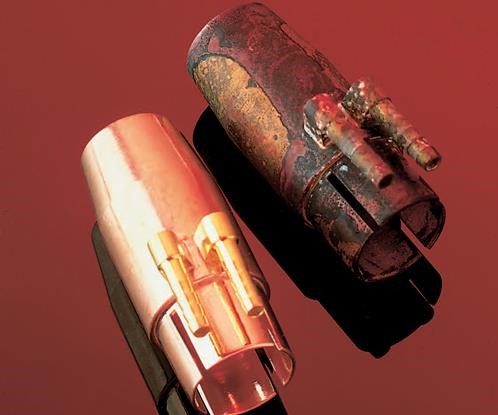A Closer Look at Electropolishing
Electropolishing is often referred to as a “reverse plating” process. Electrochemical in nature, the process uses a combination of rectified current and a blended chemical electrolyte bath to remove flaws from the surface of a metal part.
Electropolishing has been evolving since the mid-20th century, when scientists first started commercially treating metals with the combination of electricity and industrial chemicals. Since then, the process has grown more sophisticated, and now it can be used to make microscopic changes to metal parts.
Electropolishing is often referred to as a “reverse plating” process. Electrochemical in nature, the process uses a combination of rectified current and a blended chemical electrolyte bath to remove flaws from the surface of a metal part. (and can be used for removing heat tint and oxide scale). Precise monitoring removes between 0.0001 and 0.0015 inch (per surface) to produce the desired result.
The typical electropolishing installation is deceptively similar to a plating line. A power source converts AC current to DC at low voltages. A tank typically fabricated from steel, and rubber-lined, is used to hold the chemical bath. A series of lead, copper or stainless steel cathode plates is lowered into the bath and installed to the negative side of the power source. A part or group of parts is fixtured to a rack made of titanium, copper or bronze. The rack, in turn, is fixtured to the positive side of the power source.
The metal part to be electropolished is charged positive (anodic) and immersed into the chemical bath. When current is applied, the electrolyte acts as a conductor to allow metal ions to be removed from the part. While the ions are drawn toward the cathode, the electrolyte maintains the dissolved metals in solution. Gassing in the form of oxygen occurs at the metal surface, furthering the cleaning process.
Once the process is completed, the part is run through a series of cleaning and drying steps to remove clinging electrolyte. The resultant surface is clean and bright. In fact, the bright surface is the most identifiable trait, and the one that helped coin the name “electropolishing.”
Benefits
While the process is best known for the bright polish left on the surface, there are some important, often overlooked benefits of this metal removal method. These benefits include deburring, size control, microfinish improvement and others that can offer great promise to design and production engineers looking to lower costs and still provide a better product.
Although the process is roughly 65 years old, substantial refinements have taken place. Many electrolytes have been developed to allow for electropolishing of a range of metals. These newer electrolytes, together with advanced parts handling techniques, have combined to improve production yields on a range of metal products.
Passivation Parallel
Passivation is a chemical process that is used to help restore contaminated stainless steel to original corrosion specifications. Parts are placed in baskets and submersed into a diluted nitric acid or citric acid solution for a specific length of time and temperature. This process is designed to remove free iron or other foreign matter from the surface of the metal. Passivation, however, is not effective for removing heat tint or oxide scale as a result of heat treating or welding. Other than giving the part a clean finish, the process does not brighten or change the part appearance.
To attain a contaminant-free part, it may be necessary to add a pre-cleaning operation, such as vapor degreasing or alkaline cleaning. In the past, passivation was typically preceded by a pre-cleaning process known as “pickling.” The pickling solution, made from a hydrofluoric acid mixture, was used for dissolving embedded steel flecks and removing the heat tint and oxide scale. Due to EPA regulations, most companies have eliminated pickling. Without this aggressive pre-cleaning operation, in many cases, passivation does little to improve the corrosion resistance of stainless steels.
The electropolishing process is often used as a more aggressive alternative to passivation (per ASTM B912 and ASTM A967) and does not require a separate treatment. Since the process removes the outer skin of metal, embedded contaminants that can cause sub-surface corrosion are eliminated. The electropolished part is left in a homogenous and passive condition.
An Effective Option
Since electropolishing removes surface metal, all surface impurities are removed as well. Heavily contaminated surfaces such as machined parts, welded or brazed assemblies or other components that typically respond poorly to passivation alone are good candidates for electropolishing. Several popular grades of stainless steel cannot be passivated because of low levels of chromium and nickel. When these stainless steels are passivated by standard methods, the resultant flash attack actually weakens the base material and does irreparable damage to the part.
Just as electropolishing is used to enhance corrosion resistance on stainless steel, it offers corrosion resistance on other alloys as well. Many companies use the process to delay the corrosion properties of copper, brass, aluminum and carbon steels. On these and other alloys, the removal of surface skin and impurities enhances the corrosion resistant properties of the component. For components needing light corrosion resistance that cannot afford an expensive plating operation, electropolishing may be a solution.
Read Next
5 Aspects of PMTS I Appreciate
The three-day edition of the 2025 Precision Machining Technology Show kicks off at the start of April. I’ll be there, and here are some reasons why.
Read MoreEmerging Leaders Nominations Now Open
Here’s your chance to highlight a young person in your manufacturing business who is on the path to be a future leader moving your company forward.
Read MoreDo You Have Single Points of Failure?
Plans need to be in place before a catastrophic event occurs.
Read More










.jpg;maxWidth=300;quality=90)









